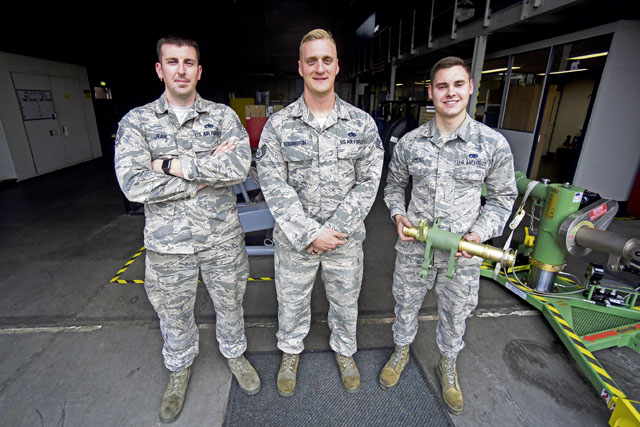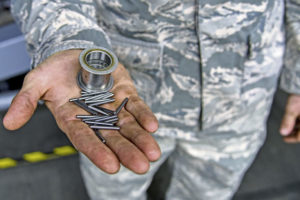
U.S. Airmen assigned to the 86th Maintenance Group on Ramstein Air Base, performed unusual repairs following a resupply mission to Libya, Aug. 14.
On the way back to Ramstein, loadmasters noticed a leak in the aileron boost pack which caused hydraulic fluid to spray the inside of the aircraft. The crew called an in-flight emergency and landed immediately.
The team landed in Naval Air Station Sigonella, Sicily, notified their leadership of the issue, and requested the parts needed for repair.
While waiting for the parts to arrive, the Airmen began preparing to remove the damaged parts from the aircraft.
After removing panels underneath the flight deck, Staff Sgt. Christopher Edgington, 86th Maintenance Squadron repair and reclamation craftsman, and Staff Sgt. Christopher Torres, 86th Aircraft Maintenance Squadron flying crew chief, noticed a number of bearings rolling around the bottom of the aircraft, signaling more damage had occurred.
“The repairs were unusual and required a lot of patience,” said Torres. “There’s no room for error, especially when dealing with flight controls. You really have to take your time and constantly double check everything.”
After relaying the additional information back to their leadership, the crew realized there would be no manuals regarding the repair because the manufacturer pressed the bearings in mechanically. This meant the repair would also require a new rudder tube assembly.

The setback meant additional personnel, rigging equipment and other tools would also be required because of the technical nature of the repair.
“No one in our shop has ever done this repair before,” said Senior Airman Kaleb Lemons, 86th MXS repair and reclamation journeyman. “An aircraft can typically go its entire lifespan without us replacing these parts.”
With the new rudder tube assembly on order, it would take several weeks before the new part could be delivered to the aircraft. However, to get the aircraft fully mission capable again, the 86th MXG cannibalized the rudder tube assembly from an aircraft on Ramstein and sent it as the replacement.
“I think we were pretty prepared going down there,” said Lemons. “We had the experience of removing the part home-station. We went through the job guide and had the tools we needed; there wasn’t anything we needed down there that we didn’t have access to.”
The team was able to repair the aircraft in about 12 man-hours, making it fully mission capable and ensuring its safe return home.
“This was actually my first temporary duty assignment, so I really felt like I made an impact on the mission,” said Lemons. “This was the first time I went to a plane that could not fly and because of what we did we were able to fix it and bring it home safely.”


